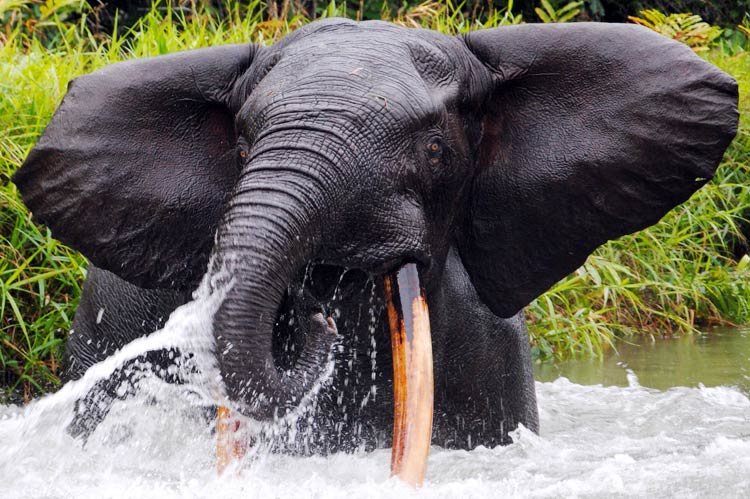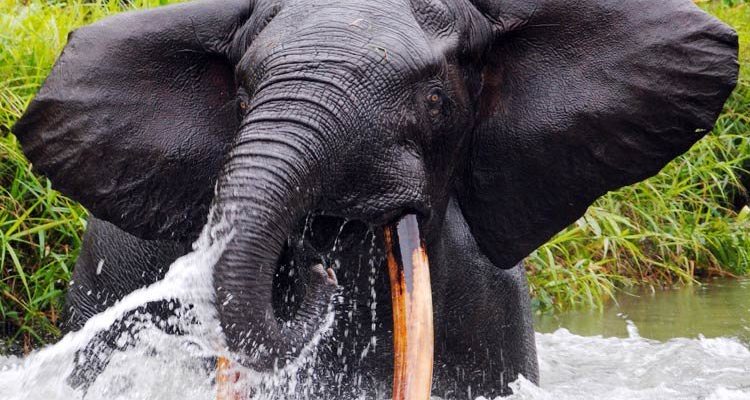
Think of them as the shy, introverted relatives of the big, boisterous family of elephants. While they tend to avoid interactions with people, situations can arise that might put humans at risk. Understanding the behaviors and habitats of these gentle giants can shed light on whether they pose a real danger. So, let’s dive into the world of the African forest elephant and see what we can learn!
What Makes the African Forest Elephant Unique?
The African forest elephant (Loxodonta cyclotis) has some fascinating characteristics that set it apart from its savanna counterpart. Firstly, these elephants are smaller, standing about 8 to 10 feet tall at the shoulder. Their bodies are designed for navigating through dense forest vegetation, giving them a more compact appearance. Their smaller size doesn’t mean they’re any less impressive; in fact, they possess some unique features that help them thrive in their habitat.
Another key difference is their smaller tusks and straighter, thicker trunks. These adaptations are perfect for reaching leaves and fruits high up in the trees, which make up a significant part of their diet. This specialized diet is crucial for survival in the forest, where food can be scarce. Their social structure is also quite interesting, as they tend to live in smaller family groups compared to the large herds typical of savanna elephants.
So, why does this matter when considering their potential danger to humans? Understanding their behaviors and environment gives us insight into how they might react when encountering people.
The Nature of African Forest Elephants
African forest elephants are generally known for being shy and reclusive. They spend most of their lives hidden among the trees, foraging for food and socializing within family groups. This secretive lifestyle means they often avoid human interactions. However, here’s the thing: when their habitat is threatened or when they feel cornered, their behavior can change dramatically.
You might be wondering what can provoke these elephants. Well, activities such as logging, mining, or human encroachment on their territory can lead to stress and aggression. Imagine being in a crowded room where everyone keeps pushing into your personal space—eventually, you might react defensively. Elephants experience a similar feeling when their natural habitat is invaded.
Encounters Between Humans and African Forest Elephants
While most encounters between humans and African forest elephants end without incident, there are circumstances where things can escalate. In areas where local communities share borders with elephant habitats, conflicts can arise. These can occur when elephants raid crops or approach villages in search of food, leading to potentially dangerous situations.
One notable incident occurred in Cameroon, where elephants made headlines for entering a village and causing destruction in search of food. Residents, understandably, felt threatened, leading to tense standoffs. In such cases, elephants may display aggressive behavior like trumpeting, charging, or even attempting to push or knock down obstacles in their way.
The key takeaway here is that while these elephants are generally non-aggressive, their behavior can change dramatically if they feel threatened or provoked. Learning how to coexist with them is vital for the safety of both elephants and humans.
Do African Forest Elephants Attack Humans?
While it’s essential to acknowledge the potential dangers, genuine attacks on humans by African forest elephants are quite rare. Most of the time, they want to avoid conflict just as much as we do. However, there are always exceptions. Factors such as the elephant’s age, health, and environmental stressors play a significant role in their reactions.
Young males, especially during the musth period (a time of heightened hormones), can be more aggressive and unpredictable. They might act out if they feel threatened or challenged, particularly in encounters with humans who stray too close to their territory. On the other hand, mother elephants are fiercely protective of their calves, and if they perceive a threat to their young, they may charge to defend them.
Here’s a relatable analogy: think of a mother bear. She’s typically not a danger to humans, but if you approach her cubs, you’re likely to provoke a defensive reaction. In the same way, elephants have their own triggers that can lead to aggression.
How to Stay Safe Around African Forest Elephants
If you ever find yourself in a region where African forest elephants roam, keeping a few safety tips in mind can help reduce the likelihood of dangerous encounters. Here’s a simple guide:
- Stay Calm: If you spot an elephant, avoid sudden movements or loud noises. They can sense fear and may react unpredictably.
- Keep Your Distance: Respect their space. Try to observe them from a safe distance, ideally behind a barrier or vehicle.
- Know Their Signs: Watch for body language. Signs of distress include trumpeting, flapping ears, and tail swishing. If you notice these behaviors, it’s best to retreat.
- Be Aware of Your Surroundings: If you’re in a village near elephant territory, stay alert. Avoid walking alone at dawn or dusk when elephants are more active.
Remember, it’s all about respect and understanding. Elephants are incredible creatures that play a vital role in their ecosystem. Keeping a healthy distance allows both humans and elephants to thrive.
Conservation Efforts and Human-Elephant Conflict
Conservation organizations are working tirelessly to protect the African forest elephant and minimize human-elephant conflicts. Many initiatives focus on educating local communities about elephants and promoting coexistence.
Some teams provide resources to help farmers construct protective barriers around crops, reducing the temptation for elephants to raid fields. Others are exploring ways to create corridors that allow elephants to move safely between areas without coming into contact with human populations.
It’s a challenging balance to strike, but when both elephants and humans respect each other’s territory, it can lead to a more harmonious existence. Honestly, it’s all about working together—and it’s heartening to see communities come together to find solutions that benefit everyone.
The Future of the African Forest Elephant
The future of the African forest elephant hangs in the balance. With threats like poaching and habitat loss, their populations are dwindling. Understanding their behavior and potential danger to humans is just one aspect of the larger picture. It’s crucial to help protect these magnificent creatures for generations to come.
By raising awareness and creating sustainable practices, we can ensure that the African forest elephant continues to roam its forest home. In doing so, we not only help preserve a species but also foster a greater respect for wildlife.
In conclusion, while the African forest elephant can be dangerous under certain circumstances, most encounters are peaceful. By respecting their space and understanding their behavior, we can coexist with these gentle giants and ensure their survival. So, the next time you hear about elephants, remember there’s so much more to them than meets the eye!

